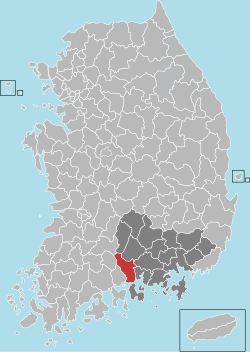Hadong County
County in Yeongnam, South Korea From Wikipedia, the free encyclopedia
County in Yeongnam, South Korea From Wikipedia, the free encyclopedia
Hadong County (Korean: 하동군, Hadong-gun) is a county in South Gyeongsang Province, South Korea. It is on the far-west side of the province, bordering South Jeolla Province. The county office is located at Hadeong-eup.
Hadong
하동군 | |
|---|---|
| Korean transcription(s) | |
| • Hangul | 하동군 |
| • Hanja | 河東郡 |
| • Revised Romanization | Hadong-gun |
| • McCune-Reischauer | Hadong-kun |
 Location in South Korea | |
| Country | |
| Region | Yeongnam |
| Administrative divisions | 1 eup, 12 myeon |
| Area | |
| • Total | 675.53 km2 (260.82 sq mi) |
| Population (September 2024[1]) | |
| • Total | 40,909 |
| • Density | 85.9/km2 (222/sq mi) |
| • Dialect | Gyeongsang |
| Website | https://www.hadong.go.kr |
The county of Hadong was called Dasachon (Korean: 다사촌; Hanja: 大沙县, "county of much sand") when it was a part of the Jin state, later becoming a part of Nangnoguk (Korean: 낙노국; Hanja: 樂奴國), one of twelve statelets of the Byeonhan confederacy. According to the History of the Three Kingdoms, the region was called Handasa-gun (Korean: 한다사군), then changed into Hadong-gun in 757 CE, during the reign of King Gyeongdeok of Silla. During the Goryeo dynasty, the area was known as Hadong-hyeon (Korean: 하동현). In 1414, during the reign of the Joseon-era King Taejong, it became known as Hanamhyeon (Korean: 하남현) with Namhaehyeon (Korean: 남해현). It was raised to the status of Hadongdohobu (Korean: 하동도호부) in 1740, in the thirtieth year of King Sukjong's reign.[2] During the Korean War the region was the site of a North Korean attack on US Army forces, the Hadong Ambush.
Nestled between the Seomjin River and Mount Jiri, the county is a popular destination for both domestic and foreign tourists who enjoy nature.[3] Parts of the Jirisan National Park lie within the county and form the county's notable hilly, mountainous landscape.[4]
The Ssanggyesa (Ssangye Temple) is a notable historic temple of the Jogye Order of Korean Buddhism and is a designated National Treasure.
Pak Gyeongni's 16-volume novel Land is partly set in the village of Pyeongsa-ri (Korean: 평사리; Hanja: 平沙里) in Agyang-myeon, Hadong County. A replica of the fictional Choi family's home was built there to commemorate the author's legacy.[3][5]
Hadong has been famous for its green tea since the Silla era, when an envoy brought green tea seeds from the Tang Empire to be planted locally.[3] The local government has historically promoted this as a major local attraction, including sponsoring a tourism advertisement that aired on CNN in 2007.[6] The annual "wild tea" festival, lasting 25 days, takes place during May and June.[3][4]
While much of Korea has experienced an explosion of industrial development, Hadong remains a destination for those who wish to escape the bustle of city living.[original research?] However, a lack of activity in the industrial sector has left the government with little incentive to expanding the sometimes inadequate existing road infrastructure.[original research?] A petition for the allocation of funds for new road construction was signed by a number of Hadong residents.[7]
Former South Korean president Lee Myung-bak has recently[when?] announced plans for the construction of a Gyeongsangnam-do leisure resort palace in Hadong.[8]
Hadong is twinned with:
Seamless Wikipedia browsing. On steroids.
Every time you click a link to Wikipedia, Wiktionary or Wikiquote in your browser's search results, it will show the modern Wikiwand interface.
Wikiwand extension is a five stars, simple, with minimum permission required to keep your browsing private, safe and transparent.